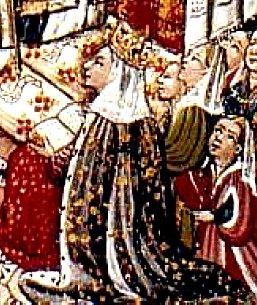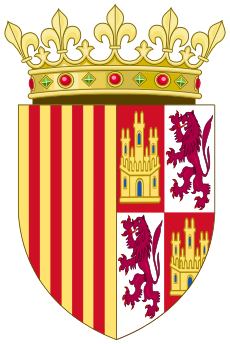Maria of Castile facts for kids
Quick facts for kids Maria of Castile |
|
|---|---|
 |
|
| Queen consort of Aragon | |
| Tenure | 2 April 1416 – 27 June 1458 |
| Queen consort of Naples | |
| Tenure | 2 June 1442 – 27 June 1458 |
| Born | 14 November 1401 Segovia, Crown of Castile |
| Died | 4 September 1458 (aged 56) Valencia, Kingdom of Aragon |
| Burial | Royal Monastery of the Trinity, Valencia later Piccolomini Chapel, Sant'Anna dei Lombardi, Naples |
| Spouse | |
| House | Trastámara |
| Father | Henry III of Castile |
| Mother | Catherine of Lancaster |
Maria of Castile (born November 14, 1401 – died September 4, 1458) was a powerful queen. She became the Queen of Aragon and Naples. She was married to Alfonso V of Aragon. Maria often acted as the regent (a ruler who governs when the king is away or too young). She governed Aragon for many years because her husband was often absent. Her time as regent lasted from 1420 to 1423 and again from 1432 to 1458. For a short time, she was also the Princess of Asturias. This title meant she was next in line to the throne of Castile. She received this title in 1402 after her father, Henry III of Castile, passed away.
Contents
Early Life and Family
Maria was the oldest child of King Henry III of Castile and Queen Catherine of Lancaster. Her godmother was her mother's aunt, Maria de Ayala. Maria grew up in Castile, which was unusual for a princess who would marry a foreign prince. Her education was overseen by Pedro González de Mendoza. Her governess was Inés de Ayala y Toledo.
Princess of Asturias
As the king's oldest child, Maria was given the title of Princess of Asturias. This title was for the person first in line to the throne. Her father officially recognized her as the heir presumptive (the likely heir, but someone else could still be born to take their place). This happened at the Cortes of Toledo on January 6, 1402. At the same time, she was promised in marriage to her cousin, Alfonso V of Aragon. He was the son of her uncle, Ferdinand I of Aragon. This marriage was planned to make her position stronger.
However, her younger brother, John II of Castile, was born later. He became the future king. This meant Maria was no longer the first in line. From then on, she was known as an infanta (a royal princess).
A Close Family
Maria had a happy childhood. Her health was not a problem until she was older and married. Her father died when she was four. This left the crown to her brother, John II. Maria became the heir presumptive again. Her mother, Queen Catherine, ruled Castile as regent while King John II was young. Maria learned a lot by watching her mother's political skills. This helped Maria understand her own duties as a queen and regent. Maria and her mother were very close. They wrote to each other often, even after Maria got married.
Her Royal Marriage
Maria and Alfonso's engagement became official when she was seven. King Henry III confirmed it in his will. This plan also included other marriages. Maria's brother John was to marry Alfonso's sister, Maria of Aragon, Queen of Castile. Maria's sister, Catherine of Castile, Duchess of Villena, was to marry Alfonso's brother, Henry, Duke of Villena.
Wedding Day
Maria and Alfonso were married in the Cathedral of Valencia on June 12, 1415. The wedding was performed by Antipope Benedict XIII. He also gave a special dispensation (permission from the Church) for their marriage. Maria received a large dowry (money or property given by the bride's family). It included land and income. Alfonso was made an infante of Castile. Later, Maria's brother would say that her dowry was the largest ever given to a Castilian infanta.
Challenges in Marriage
Maria often had delicate health. She may have had epilepsy. She also had smallpox, which left scars. Maria and Alfonso did not have any children. This lack of children greatly affected their marriage and Alfonso's rule. Their relationship became difficult around 1423. Despite the challenges, they remained married for political reasons.
Queen and Regent
Less than a year after her marriage, on April 1, 1416, King Ferdinand I died. This made Maria's husband the new king and Maria the Queen of Aragon. Maria was ill and could not attend her father-in-law's or her mother's funerals. Unlike most queens of Aragon, Maria was never officially crowned queen.
At first, Maria stayed out of politics. She let her powerful mother-in-law, Queen Eleanor, take the lead. Maria only became more active when her mother-in-law's health got worse.
Ruling Aragon
In 1420, Alfonso left Aragon to claim the throne of Naples. He did not trust his ambitious brothers to rule in his place. So, he made Maria his regent. Before he left, he gave her a document. It said she had almost as much power as he did and could govern as if she were the king.
Since the King was away for most of his reign, Maria was the de facto (in practice) ruler of the kingdom. She held the title of lieutenant-general. Even though many of her personal staff were from Castile, Maria wisely appointed only Aragonese people to important jobs during her regency. This made her popular and helped her court run smoothly.
Her first time as regent was from 1420 to 1423. Her second time was from 1432 until her husband's death in 1458. During these times, she had to deal with conflicts between citizens and farmers. When Alfonso was captured in Italy in 1435, Maria raised the money to free him.
On one occasion, Queen Maria of Aragon (this Maria) and Queen Maria of Castile (her cousin and sister-in-law) helped create a peace treaty between Aragon and Castile. This happened in Valladolid. People said that if the Queen of Castile had as much power as the Queen of Aragon, there would have been peace in Spain. In 1454, after her brother died, Maria traveled to Castile. She went to negotiate with her nephew, Henry IV of Castile, who was the new king. She stayed in Arévalo, Castile, until the year before she died in 1458.
 In Spanish: María de Castilla (reina de Aragón) para niños
In Spanish: María de Castilla (reina de Aragón) para niños


